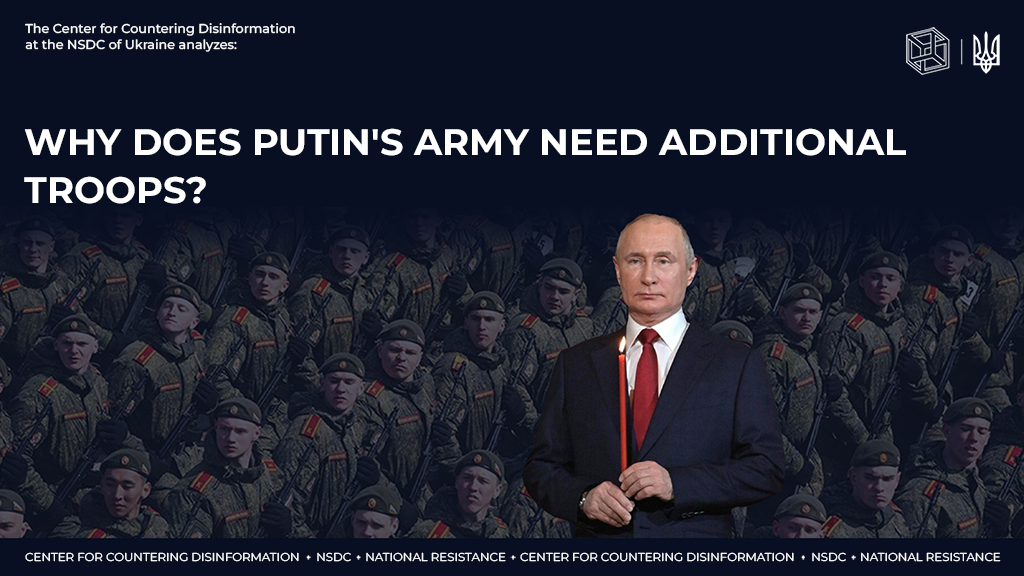The Center for Countering Disinformation at the National Security and Defense Council of Ukraine is analyzing Putin’s decree on increasing the number of Russian Armed Forces from 1,9 million to 2 039 758, including 1 150 628 military personnel. According to the mentioned decree, which will have the force from the beginning of 2023, the number of military personnel of the Russian Federation will increase by 137 thousand.
It is known from open sources that in 2022 the number of Russian Armed forces was 2 039 758 of which 1 150 628 were military personnel. But before Russia’s full-scale invasion of Ukraine, it had only about 850 000 active-duty troops. This differed greatly from its nominal target number of over 1 million.
The number of soldiers in the armed forces of the Russian Federation constantly fluctuated. In particular, in the period from 1992-1996, it decreased from 2,75 million to 1,6 million, and in 2003 it amounted to 1,16 million military personnel. In 2006, the number was 2 020 500 people, including 1 134 800 military personnel, and in 2017 – 1 902 758 and 1 013 628 people.
In the Russian infospace, the need to increase the number of military personnel is explained by “absolute changes in the military-political situation around the Russian Federation” and “NATO actions in Europe and Ukraine.” In particular, in view of joining NATO by Finland and Sweden, there was a need to form additional 12 new military detachments, where the new military personnel will go.
Propagandists of the Russian Federation convinced that “increasing the number of employees of the Armed Forces of the Russian Federation has nothing to do with mobilization.” And it is being planned to strengthen the ranks of the military “exceptionally at the expense of contract professionals, which will not lead to an increase in conscription.”
The Russian Federation also states that against the background of the “special operation” the number of those who are willing to serve under a contract has increased rapidly, but Russian law limits the number of the contract workers to 600 000. According to the previous statements of the Minister of Defense of the Russian Federation S. Shoigu, the number of contract workers in 2020 was 405,1 thousand people, and by 2025 it should reach 475,6 thousand people.
Military experts of the Russian Federation believe that due to the new replenishment, it is necessary to strengthen the border troops, the Navy and the space group, and there is also a great demand for tankers, artillerymen and “cyber warriors of information space”.
The occupiers believe that the territories seized by them will be considered finally as “liberated” only in the case of permanent deployment of the armed forces of the Russian Federation. It is on the TOT that they need permanent garrisons with specialists in scouting, anti-terror, and law enforcement. That is, 137 000 recruits should be sent to the “liberated Ukrainian territories” for military support.
They consider the fact that in March of this year by Putin’s decree 134,5 new recruits have already been called up for military service and in autumn of 2021 the amount is 127,5 thousand new recruits like a simple coincidence. But it is not excluded that Russia can use the autumn draft in October 2022, which could attract about 130 thousand people.
Whereas two previous conscription campaigns were not full of enthusiasm, information about the soldiers who died in the war in Ukraine will make the next conscription more difficult. In other words, the Russian “dembele” must mentally prepare that their service will be extended.
Also, more than 40 volunteer units have been created in Russian regions, which send conscripts to fight in Ukraine. It is known about the formation of such units in St. Petersburg, Yakutia, Primorye, Kazan, Chuvashia, Perm Krai, Amur Oblast, and Leningrad Oblast.
The units consist of compatriots, their name indicates territorial affiliation, but they are not formally part of the army of the terrorist country. It is also possible to formally include fighters from the ORDLO in the official armed forces of the Russian Federation in the event of the annexation of the temporarily occupied territories of Luhansk and Donetsk regions to Russia.
According to the General Staff of the Armed Forces of Ukraine, since the beginning of the Russian invasion of Ukraine, as of August 26, about 46 250 Russian servicemen have been eliminated. The Minister of Defense of Great Britain believes that the total losses of Russia in the war in Ukraine for six months amount to more than 80 thousand of its armed forces, if we count together the killed, wounded and deserters. His colleagues from the USA also consider Russian losses to be about 70-80 thousand soldiers killed and maimed.
In earlier periods of the war, the ratio between killed and wounded was estimated as one to two. So, it can be predicted that the number of 137 000 is a recognition of the real losses of the Russian army, which needs compensation. And this is without the so-called militias and mercenaries of private military companies.
Thus, first of all, Putin’s decree on increasing the number of military personnel is a continuation and formalization of the covert mobilization that has been ongoing in the Russian Federation since the spring. This will allow Russia to maintain its control in the Caucasus or in Armenia and strengthen its presence on the western borders with new NATO members and in controlled Belarus.
It should be noted that immediately after the publication of the decree, it was urgently systematically and massively disseminated by the Russian mass media. This shows that the main purpose of this document at this stage of the war is to have an informational and psychological impact on Ukraine and our Western partners.
Such demonstration of the threat of readiness for a long war should push us to negotiations with the fixation of the current “territorial realities”. It is also a sign that the Kremlin is avoiding a general open mobilization in Russia for the time being, because it is difficult due to economic problems and the lack of arguments for the Russian population.










